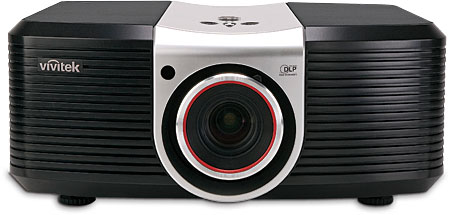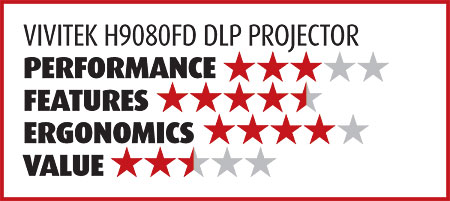Vivitek H9080FD LED-Based DLP Projector Page 3
 Testing and Viewing
Testing and Viewing
The first H9080FD I received had a very soft focus, much softer than Vivitek or I thought it should be. A second unit was noticeably better, but it still had some issues. A bright white crosshatch pattern showed more color fringing than I expected from a single-chip DLP in this price range. Such aberrations are more tolerable when they’re confined to the edges of the screen. However, the fringing here with red was clearly visible at the top and bottom of the center screen area. Green fringing was also clearly visible at the right side of the screen. Since this is a single-chip devicethe likeliest culprit is the lens/optics. While it showed the highest frequencies in our luma and chroma bursts, the Vivitek didn’t resolve these patterns as crisply as I’ve seen. The Vivitek’s focus at the pixel level could compete with my JVC DLA-HD750 (a three-chip D-ILA projector). This is certainly very good, but it’s not nearly as sharp as the best single-chip DLPs I’ve seen. The image had nice detail, but I had hoped for more.
I saw very solid detail with the best film-based Blu-rays I have, such as The International. The opening scenes cut from a close-up of an unshaven and very grizzled-looking Clive Owen (I think he was channeling Nick Nolte) to a clandestine meeting in an Audi sedan on a rainy day. The Vivitek nicely resolved Owen’s wrinkles, whiskers, and scraggly hairs, as well as the textures in the interior of the car and the actors’ clothes. The best computer-animated fare was as eye-popping as you’d expect. I rewatched Monsters vs. Aliens and was struck again at the level of detail in the character rendering. In particular, the computer-generated skin textures in the humans and monsters were remarkably nuanced. It looked like you could reach out and pet all that animal fur in Madagascar: Escape 2 Africa. Vivitek’s light output probably aided these impressions. At nearly 14 foot-lamberts on my 92-inch-wide screen, it’s a bit brighter than my lamp-driven JVC DLA-HD750 is at 500-plus hours. If the promise of LED lighting pans out as anticipated, the projector should not lose light output as the LEDs age. At least it shouldn’t lose it at a rate close to what lamp-based projectors experience. These attributes also made the Vivitek a standout with high-def sports broadcasts, which seldom challenge with blacks and contrast but love light output and resolution.
To get the best blacks and contrast, I engaged the Dynamic Iris. As I mentioned earlier, this wasn’t a free lunch. With most scenes, the blacks and contrast are very good. But at the lowest Dynamic Iris setting, I still saw pumping artifacts more often than I wanted to. I could clearly see the overall brightness level ramp up and down to a distracting degree when a scene shifted from lighter to darker imagery or vice versa. The best dynamic systems mask this effect better than the H9080FD. Like many of these dynamic systems, this one also suffers from brightness compression. Details that should be visible are crushed out of areas of the image with bright highlights. This is seldom visible with program material, but it’s distracting when you can see it. Higher settings for the Dynamic Iris provide better contrast ratio measurements. However, these aren’t practical, as they make artifacts go from distracting to outright unbearable. The Runco LS-5 DLP projector I reviewed in the May 2010 issue costs just $7,000, and while it occasionally shows brightness compression artifacts, I never saw any noticeable pumping.

The Vivitek’s colors looked every bit as good as they measured. They delivered fleshtones that always looked right and a beautifully saturated but not overbearing palette. Greens and reds, which many digital projectors still skew, were rich and intense but never off kilter. The Vivitek was spot on all the way. The Gennum-based video processing was also superlative. This solution superbly handled 1080i-to-1080p conversions and the little DVD material I watched. Regardless of what you put into this projector, the video processing will handle it expertly.
Conclusions
Vivitek’s H9080FD is a first-generation LED-based projector, and it’s the first I’ve seen. It does a number of important things strikingly well, particularly color and gray-scale tracking. With its LED lighting, it should maintain this admirable performance over time. However, it doesn’t match the sharpness, blacks, or contrast of a number of the best high-end-priced projectors we’ve tested. These are crucial performance parameters that most viewers will notice. In addition, its native contrast isn’t strong enough to avoid using the Dynamic Iris feature, which causes artifacts at its lowest setting. The H9080FD isn’t far off from being outstanding, but there’s no margin for error at $15,000. This is a solid start, and I look forward to seeing a second-generation LED projector from Vivitek that addresses these points.

























































